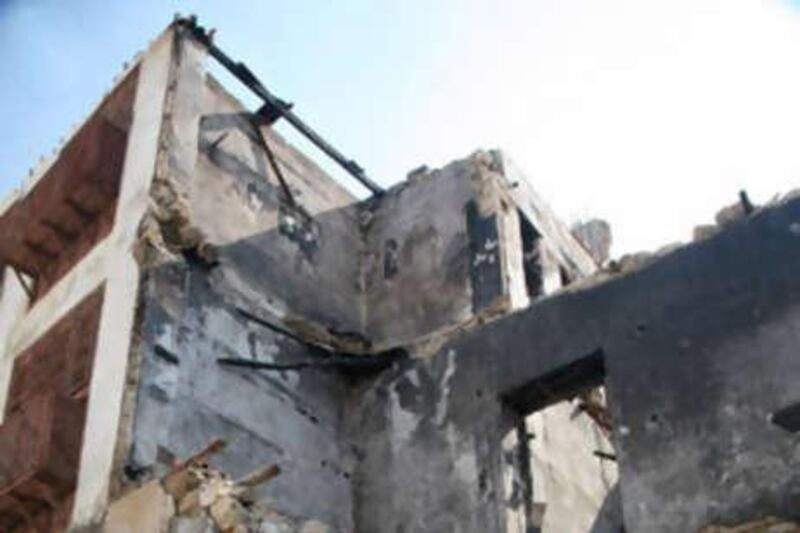JEDDAH // Members of the Municipal Council in the kingdom's largest city said that the municipality was not doing enough to evacuate residents as a spate of recent building collapses have added to Jeddah's growing housing crisis. The number of people in need of housing is expected to significantly rise as authorities plan to evacuate or remodel an estimated 8,000 buildings classified as unfit for living.
Concerns over old buildings have mounted after two Somali women died in a house that collapsed on Friday in Al Boghdadiyah district, bringing the total number of collapsed buildings to four in the past six weeks, leaving eight people dead. Khalid Zaini, the co-ordinator for the committee overseeing uninhabitable buildings at the Jeddah municipality, said in a statement on Saturday that the committee had finished assessing more than 3,000 buildings that are of concern. The committee decides which buildings will be torn down and has notified residents in 1,000 homes that they need to evacuate, Mr Zaini said. He added that it was co-ordinating with the Saudi Electricity Company to cut off power in almost 6,000 buildings that are considered a threat to the life of their residents. "We need to force them to evacuate. This is necessary to save lives."
However, according to the members of Jeddah's elected Municipal Council, the efforts made to evacuate people were not good enough. Council members have criticised what they called the slow pace of work to solve this problem. Bassam Akhdar, a council member, said that the municipality was "incompetent" to fix the situation as at least one building is collapsing almost every 10 days. "Three million people living in Jeddah are now concerned about the 6,000 old buildings that are threatening the lives of its residents."
Fires and collapses have wiped out many of Jeddah's old buildings. Jeddah's Al Balad district has lost seven buildings a year since 1980, classed as historical. A building is designated historical if it is at least 100 years old and is certified by the commission of tourism and antiquity. Thousands of people in Jeddah at the moment are looking for new places to stay after losing their homes in the floods that killed more than 120 people in November. With the new evacuation and remodelling scheme, the number of people searching for new homes will jump sharply.
"We are still counting buildings that are unfit for living and we will not evacuate anyone at the moment," said Brig Abdullah al Jeddawi, the director general of civil defence in Jeddah. Brig al Jeddawi said that Mr Zaini's committee, formed by the civil defence, Jeddah municipality and Saudi Electricity Company, had been assessing the situation for a long time. The committee is working on sending notices and warnings on evacuation and remodelling to the residents of the "unfit" buildings.
"Once we finish counting the unfit buildings, the municipality will take over and it will decide what to do with them," Brig al Jeddawi said. Mr Akhdar, the council member, said that he did not expect much from the municipality which, until now, failed to act properly and help people in areas damaged by last year's floods. "The municipality is waiting for all these buildings, which are becoming time bombs, to fall on people's heads so that they can attribute the incidents to fate and destiny.
"If the leader of this country didn't intervene to solve the people's problems, the municipality would have stayed idle and observing till now," Mr Akhdar said, referring to King Abdullah's orders to compensate victims following the floods. King Abdullah gave flood survivors 1 million riyals (Dh980,000) for each casualty and to compensate people who lost homes and cars in the floods. He also ordered an investigation into officials at the municipality, who were responsible for the city's infrastructure and water drainage system.
"We need to act fast and evacuate these unfit buildings and move their residents to newer and better places," Mr Akhdar said. Many of Jeddah's buildings collapsed in the past 30 years. The number of houses classified as historical has gone down from 557 in 1980 to 350 in 2009, according to municipality figures. In March, the district lost seven houses in one day after they collapsed in a fire. The governorate of the city and the mayoralty are working on a plan to demolish homes in at least 51 districts around the city that are classified as slum areas.
The municipality has not announced any plans for where the evicted will live once the demolitions are complete. Prince Khalid al Faisal, the governor of the Mecca region, which includes Jeddah, said in 2007 that he would demolish all the slums in the city even if he had to build the entire city from scratch. According to a recent study by the municipality, the slums constitute 16 per cent of Jeddah's land.
The municipality has said in its 20-year strategic plan to redevelop Jeddah that most land owners in the slum areas lacked proof of ownership. Officials launched an initiative in 2007 to help those living in slums by issuing them legal deeds to the proprieties they were living in. However, the number of properties built illegally on government-owned or private land is rising as more people continue to migrate to Jeddah.
wmahdi@thenational.ae





